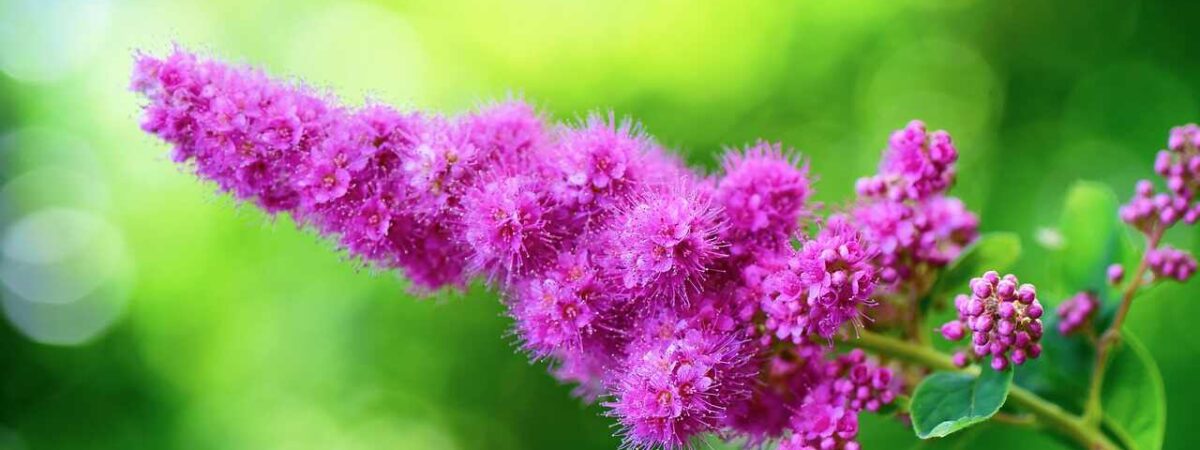Plant Overview
Spiraea, often misspelled by people as Spirea, is a quick-growing deciduous shrub that is grown specifically for its beautiful flowers in spring or summer.
Flowers of this plant are generally borne in profusion and have heads or clusters which are made up of a lot of tiny blooms, in the shades of white, pink, or purple. The white-flowered spiraeas variety is sometimes referred to as a ‘bridal wreath’.
These shrubs are very easy to grow and take care of. It makes excellent shrubs for the border of a garden, although these plants are not a good choice for pots. The size of this shrub varies considerably from plant to plant, depending on the variety.
It can attain a height of as little as 45cm high and a width of up to 2.4m, so matching the variety size of plants to their site is important. Spiraeas are generally hardy shrubs and easy to grow.
Types of Spiraea plants to grow
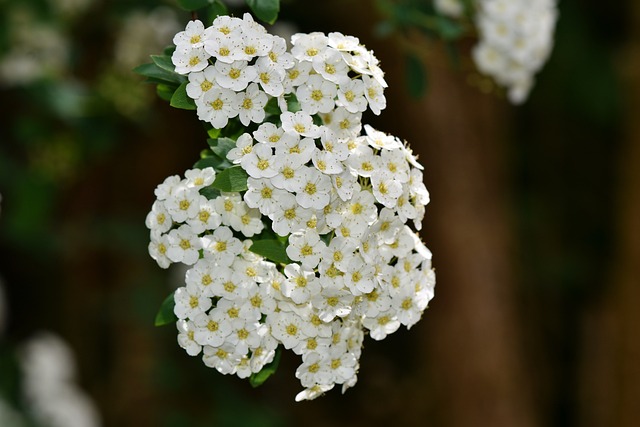
There are numerous different types of Spiraea available on the earth to grow. Here are some of the most commonly grown varieties.
Japanese Spiraea
Japanese spirea or Spiraea japonica is a popular variety of this plant that has the widest color range, along with foliage in shades of green, blue, gold, or chartreuse. The flowers of this variety bloom from late spring into summer in shades of pink, purple, red, or white.
Birchleaf Spiraea
Birchleaf spiraea or Spiraea betulifolia is another popular variety that has a dense mounding habit along with beautiful white flowers and toothed birch-like green leaves. This plant of rich fall color occurs on the earth in shades of red, orange, and purple.
Nippon Spiraea
Nippon spiraea or Spiraea nipponica, also recognized as snowmound Nippon Spiraea, is a popular variety with an upright cascading habit, snow-white colored flowers, and blue-green foliage that changes into yellow in fall.
How to grow Spiraea shrubs?

It is always suggested to plant a spiraea plant when it is in its dormant state, in garden borders. Mulch and feed your plant annually and prune it only if necessary, after flowering. The mature overgrown spiraea shrubs can be rejuvenated by selective renovation pruning. You can also propagate spiraea shrubs through cuttings in mid to late summer.
It is suggested to grow spiraea in garden borders in fertile, well-drained soil. If your soil is not fertile, you can improve it by adding well-rotted organic matter to it before planting.
Depending on the size of your plant, site your spiraea towards the back, middle or front of the border. The smallest spiraea shrubs give the best effect when they are planted in a group of three. Because of the twiggy woody growth of this plant, it does not look good during winter. So avoid giving spiraeas a prominent site to grow that’s on view all year.
Spiraeas are hardy plants and they are ideally planted in autumn, during mild spells in winter, or in early spring. You can plant your shrub while in full growth during spring or summer, as long as your plant is getting water regularly.
So while planting, make sure with the top of the rootball at the same depth just as the soil level, firm in, and water it well to settle the soil around the root of the plant.
How to care for Spiraea shrub?
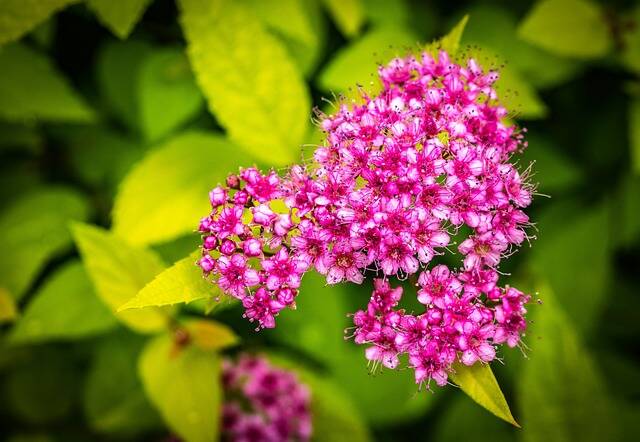
Choosing a perfect site for spiraea which drains well and gets the right amount of sunlight is essential for all of its species. It is still important, however, to do your research while searching for a suitable species of this shrub for your garden, as the care and condition requirements to grow can vary considerably.
The caring guide below is general guidelines for all the species and not specific to any particular species.
Light
The plant thrives in bright and indirect sunlight. So to achieve the best bloom production and coloration of foliage, make sure that the shrub gets full sun.
Soil
As we discussed earlier, Spiraea prefers to grow in fertile, well-drained soil that has a neutral pH. So before planting, test the acidity level of the soil. You should also recheck it ccasionally during the season to determine if soil amendments are required or not.
Water
It is suggested to keep newly planted Spiraea well-watered throughout the year until they have established themselves. After they are established, it is okay to taper off watering as watering is only necessary when the soil is dry.
This method of watering is preferred to water your plant because this genus has a great tendency to develop root rot and other overwatering diseases that can cause serious issues.
Temperature and Humidity
As we discussed earlier, Spiraea can be winter hardy down to 15 degrees Fahrenheit. It is always a good idea to check the individual details of the species, but the general range of the USDA zone is USDA 4-8, with some species, being a little bit pickier than others.
Fertilizer
The Spiraea genus is not one of the genus that requires heavy feeding. If your plant is producing healthy and vigorous blooms, then no fertilization may be needed. It is not doing so, then feeding is required that should only be done annually in the early spring with a slow-releasing fertilizer.
How to prune Spiraea shrub?
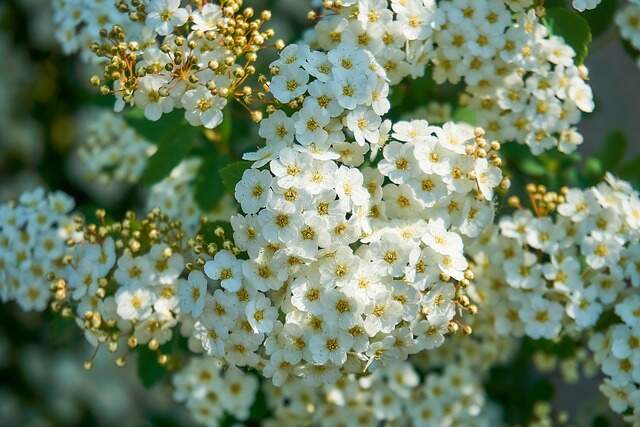
The Spiraea genus will get benefit from yearly maintenance as well as the occasional hard pruning of the plant. And because these shrubs are growers, liberal pruning has negligible impact on flowering – if it is done at the right time.
Spring flowering varieties of the plant bloom on old growth from the previous year and are required to be pruned right after flowering. Pruning can be done by cutting the Spring canes right to the ground or trimming back to any length to keep the growth compact.
The Summer flowering varieties of this genus bloom mostly on new wood from the current year’s growth, so they can be pruned in the winter following flowering. It is suggested to remove any dead wood from the plant and trim lightly to give shape.
If the summer blooms of the plant have become overgrown, more vigorous pruning might berequired. In that case, cut back the plant by as much as two-thirds especially during winter when plants are in their dormant state.
And both of these categories can also enjoy a light shear after flowering to remove spent blooms, which encourage reblooming, and invigorate foliage.
Common pests and diseases

Spiraea is a trouble-free shrub without any problems as long as it is planted in good soil. In poor soil, they are liable to dry out, and powdery mildew may appear on the leaves that cause the death of the plant.
Powdery mildew is a fungal disease that affects the foliage of the plant, stems, and sometimes flowers and fruit of the shrubs. There are a lot of species and most of them are host-specific that affect a few plants in the same family.
the symptoms of powdery mildew may include white, a powdery fungus that may spread on the leaves, stems, and sometimes flowers and fruit.
The best way to prevent the powdery mildew from forming is to grow your spiraea in full sun and water it regularly in dry weather. Mulch your plant around the roots which will help your plant to preserve soil moisture and therefore it will prevent infection. Apart from that, allow plenty of air to circulate between those plants, and don’t plant them too closely together.
Conclusion
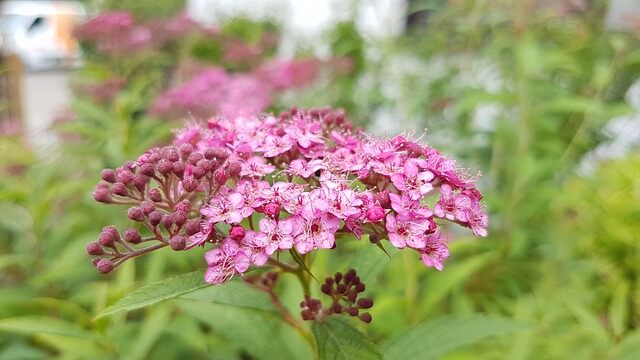
As you read the article this far, you might get an idea of how to add this beauty to your garden.
Spirea is easy to grow plant in nearly every garden. It can tolerate a wide range of conditions, including poor soil, heat, cold, humidity, drought, and urban pollution. So you can grow this beauty in your garden.
So have this beauty in your garden and let us know how it is going.
You may also like to grow

